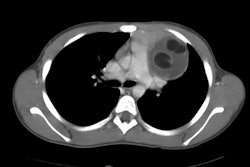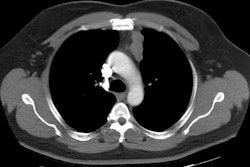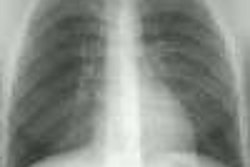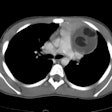Extramedullary Hematopoiesis:
Clinical:
Mediastinal extramedullary hematopoiesis is an uncommon condition that represents a proliferation of hematopoietic cells outside the bone marrow [1,3]. It is most commonly secondary to chronic anemia such as beta- thalassemia, hereditary spherocytosis, sideroblastic anemia, and sickle cell disease. More unusual causes include myeloid metaplasia, polycythemia vera, leukemia, lymphoma, and Gaucher's disease. The liver, spleen, kidney, lymph nodes, and posterior mediastinum are the most common sites [3]. Biopsy should be avoided, because excessive bleeding can occur.X-ray:
The masses of intrathoracic extrameduallary hematopoiesis most typically appear as lobulated soft tissue paraspinous masses at the T6-T12 level. They are most often multiple, bilateral, and asymptomatic. The masses enhance following contrast administration [3]. The condition can be unilateral. Other intrathoracic sites of involvement include the pleura (adjacent to the ribs) and the pulmonary interstitium [3]. Computed tomography may demonstrate the presence of fat within the mass. Tc-99m-sulfur colloid imaging may help to confirm the diagnosis.REFERENCES:
(1) AJR 1997; Chest case of the day. Extramedullary hematopoiesis (EMH).169 (July): 266-274 (No abstract available)
(2) AJR 2002; Georgiades CS, et al. Typical and atypical presentations of extramedullary hematopoeisis. 179: 1239-1243
(3) Radiology 2007; Berkmen YM, Zalta BA. Extramedullary hematopoiesis. 245: 905-908





